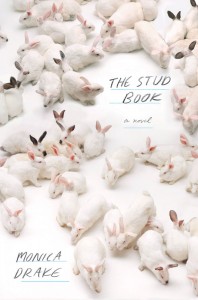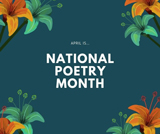 Monica Drake’s second novel, The Stud Book, is like “Friends” for the punk rock crowd, a stripped down, no-holds-barred story of 30-somethings in the various places that 30-somethings find themselves—with kids and terrified, desperately trying to have kids, or desperately against having kids. Her first book, Clown Girl, was optioned by Kristen Wiig. Monica lives in Portland, where she is Acting Chair of the newly launched BFA in Writing at the Pacific Northwest College of Art, a degree that combines studying writing with studying visual arts. She took time to answer some questions from Lindsey McGuirk of Village Books in Bellingham, WA.
Monica Drake’s second novel, The Stud Book, is like “Friends” for the punk rock crowd, a stripped down, no-holds-barred story of 30-somethings in the various places that 30-somethings find themselves—with kids and terrified, desperately trying to have kids, or desperately against having kids. Her first book, Clown Girl, was optioned by Kristen Wiig. Monica lives in Portland, where she is Acting Chair of the newly launched BFA in Writing at the Pacific Northwest College of Art, a degree that combines studying writing with studying visual arts. She took time to answer some questions from Lindsey McGuirk of Village Books in Bellingham, WA.
LM: Is there a particular character in The Stud Book you really like?
MD: The Stud Book is an ensemble, with a narrator that is aligned with multiple points of view. It’s about the question of population, to a large extent, so it seemed necessary to make use of a populated narrative. Along with the women, there are also four male characters. I see them all functioning as part of a larger whole, a community certainly, but almost an entity. That’s what a family is, right? An entity made up of seeming individuals. In writing this book I was interested in the point of intersection between the individual and community, the tension in needing autonomy and yet being social creatures, pack animals.
I loved drawing them all into play. One character at a time works against or in support of another. Humble and Ben are on opposite sides of the continuum in terms of masculinity. Sarah becomes a sort of emotional anchor for the book, but that’s largely because she carries the central question: to reproduce, or not? I love Dulcet, in her indulgence, and I enjoyed the way the character of Georgie let me raise questions about the mind and the body, the theoretical and the sensuality of experience.
LM: If Nyla, Georgie, Sarah, and Dulcet each had to give a piece of advice to soon-to-be parents, what would it be?
MD: Ha! Georgie offers some of her advice in the book–advice for hypochondriac parents, anyway. Mostly these characters have desire and fear. Georgie’s husband, Humble, might have advice, but only after the narrative is over, looking back, to see where he went so very wrong.
LM: I imagine that your book is read very differently for someone who has kids than it is for someone who doesn’t want kids. Would  you agree?
you agree?
MD: I look forward to hearing from readers about this. Because I waited until I was 39 to have a child, I think I am both of those readers, the “childless by choice” and the parent. But of course other readers will come to the material differently.
LM: There were parts in the book where, as a woman, I was actually feeling physical uneasiness from what I was reading. When you are writing, do you have to stop and take a breather or are you able to power through the tough scenes?
MD: That’s why a person writes, right? To tell those things. I’m a slow writer, though. I do take breaks. Mostly, I stop to think about a scene, to move myself into the moment, and I go out and walk my dog. I’ve decided those breaks, the dog walking breaks, are a crucial part of the writing process. When a writer takes a walk mid work writing day, it’s like moving out into the world from the point of view of the work in progress.
LM: Chuck Palahniuk sent boxes full of condoms, baby dolls, lollipops and candy cigars to booksellers to help promote The Stud Book. That is marketing at its finest. Were you in on that idea and, if so, how did that conversation go down?
MD: He is amazingly nice, isn’t he? I can’t say more. I can’t give away his secrets.
LM: Fair enough. Along with Chuck Palahniuk, you pal around with some other literary big wigs, including Chelsea Cain, Lidia Yuknavitch, and Cheryl Strayed. Give me a glimpse of what it’s like when you’re all in one room together.
MD: I’m fortunate to be in one room with all of them at least once a week in our writing workshop. Honestly, it’s amazing. We’ve been meeting for so many years that in some ways when I write I can imagine what each author might say in workshop. Chuck might ask how a chapter contributes to the overall arc of a novel. If it’s not contributing, cut it. Chelsea Cain might suggest starting farther into the story, and how to slow down to build suspense. Lidia understands the meta-story, the back story, the big picture, all the time. But despite meeting for years they all amazing and surprise me with their brilliance. It’s fresh each week. And we laugh, a lot.
LM: What are two books you always recommend to people? What are you currently reading?
MD: I’m a big fan of The Vet’s Daughter by Barbara Comyns. Also, Housekeeping by Marilynne Robinson. I’m currently reading Best American Essays. I love it. I always love it, year after year… I’m also reading Calling Dr. Laura, a graphic memoir. I just picked it up and it looks wonderful. I’m interested in graphic memoir. I read Marbles by Ellen Forney when it came out, and am using it in the class I teach. All good stuff.
Lindsey McGuirk is the Digital Marketing Coordinator for Village Books, where she handles the store’s online and social media marketing.


